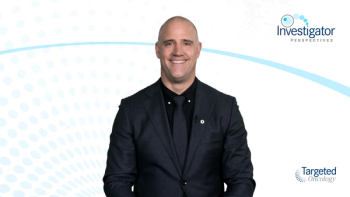
Case 1: Considerations for Cytoreductive Therapy in P. Vera
Experts in polycythemia vera discuss decision-making around when to initiate cytoreductive therapy in patients with low risk polycythemia vera.
Episodes in this series

Ruben Mesa, MD: Why don’t you share with us a bit more about your case?
Prithviraj Bose, MD: Going back to where we left off after the diagnosis, the patient was started on phlebotomy, 250 mm every other day to a target of less than 45%, and a baby aspirin daily. The hematocrit target of less than 45% was achieved within the first month. It was stable for 2 more months. At 3 months, he reported that the headaches were better and the dizziness was gone. The early satiety and pruritus were still there but had not gotten any worse. The plethora was still there, blood pressure was good, and the spleen was still at 2 cm below the left costal margin. The blood counts were still fairly similar, except the hematocrit was better at 49%—so still not at goal. White blood cell count was 22 per mm3 and platelets were 774 per mm3, so you see pancytosis, which is a signature of PV. Ferritin was only 9 µg/L, presumably from all the phlebotomy. EPO [erythropoietin] was very low, at less than 3 mU/mL.
Ruben Mesa, MD: Stephen, what are your thoughts about this case? It sounds like a fairly aggressive case. Is this individual doing well with initial therapy?
Stephen Oh, MD, PhD: There appears to have been some response to the treatment regimen thus far, but certainly not optimal. For instance, the hematocrit, as correctly pointed out, has not been brought down to below 45%, which is probably the most important treatment goal with this approach. Then you have the issue that this patient has an ongoing leukocytosis and some degree of thrombocytosis, which is less of an issue and can be quite complicated in this setting because there can be some degree of reactive thrombocytosis from the iron deficiency induced by the phlebotomies. That part is secondary, but we haven’t even achieved adequate hematocrit control with fairly frequent phlebotomies. In addition, though some of the patient’s symptoms have improved, his relatively mild splenomegaly has not changed, which you wouldn’t expect anyway with phlebotomy. I believe he still has some early satiety related to that. There are a number of things indicating that we don’t have optimal control of this patient’s disease at this point.
Ruben Mesa, MD: Jamile, is this someone that you would start on cytoreduction? What might you pick if that’s the case?
Jamile M. Shammo, MD: If someone is continuing to have symptoms, then hydroxyurea would be the go-to.
Ruben Mesa, MD: Prithviraj, do you think this individual with a little splenomegaly needs any additional staging? Would you repeat the bone marrow? Does a screen change your decision for starting frontline therapy?
Prithviraj Bose, MD: I don’t think so, Ruben. They’ve been on phlebotomy only, and as Stephen mentioned, that’s not going to shrink the spleen or make the early satiety better. It doesn’t make me want to repeat a marrow, restage, or question anything. It just goes along with the fact that this patient needs some cytoreductive therapy.
This transcript has been edited for clarity.











































